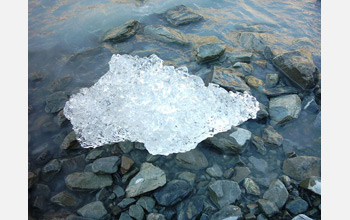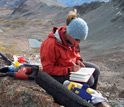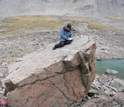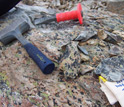News Release 10-163
Study Adds Clue to How Last Ice Age Ended
New Zealand glaciers melted as European glaciers briefly expanded

Geologists have found clues to past climate changes in New Zealand's melting glaciers.
September 8, 2010
This material is available primarily for archival purposes. Telephone numbers or other contact information may be out of date; please see current contact information at media contacts.
As the last ice age was ending, about 13,000 years ago, a final blast of cold hit Europe, and for a thousand years or more, it felt like the ice age had returned.
But oddly, despite bitter cold winters in the north, Antarctica was heating up.
For the two decades since ice core records revealed simultaneous warming and cooling at opposite ends of the planet during this time period, scientists have looked for an explanation.
Results of a new study published this week in the journal Nature bring them a step closer by establishing that New Zealand was also warming.
"New advances in the use of cosmogenic isotopes [used in this research] allow dating with hundreds of years' resolution, and correlation of key deposits such as the moraines in New Zealand," said Enriqueta Barrera, program director in the National Science Foundation's (NSF) Division of Earth Sciences, which funded the research.
"Further application of this technique will reveal the details of climate change in different regions since the last glaciations."
The finding indicates that the deep freeze up north, called the Younger Dryas for the white flower that grows near glaciers, bypassed much of the southern hemisphere.
"Glaciers in New Zealand receded dramatically at this time, suggesting that much of the southern hemisphere was warming with Antarctica," said lead author Michael Kaplan, a geochemist at Columbia University's Lamont-Doherty Earth Observatory.
"Knowing that the Younger Dryas cooling in the northern hemisphere was not a global event brings us closer to understanding how Earth finally came out of the ice age."
Ice core records show that warming of the southern hemisphere, starting 13,000 years ago, coincided with rising levels of the heat-trapping gas, carbon dioxide (CO2).
The study is the first to link this spike in CO2 to the impressive shrinking of glaciers in New Zealand.
The scientists estimate that glaciers lost more than half of their extent over a thousand years, and that their creep to higher elevations was a response to the local climate warming as much as 1 degree C.
To reconstruct New Zealand's past climate, the scientists tracked one glacier's retreat on South Island's Irishman Basin.
When glaciers advance, they drag mounds of rock and dirt with them. When they retreat, cosmic rays bombard these newly exposed ridges of rock and dirt, called moraines.
By crushing this material and measuring the build-up of the cosmogenic isotope beryllium-10, scientists can pinpoint when the glacier receded.
The beryllium-10 method allowed the researchers to track the glacier's retreat upslope through time and indirectly calculate how much the climate warmed.
The overall trigger for the end of the last ice age came as Earth's orientation toward the sun shifted, about 20,000 years ago, melting the northern hemisphere's large ice sheets.
As fresh meltwater flooded the North Atlantic Ocean, the Gulf Stream weakened, driving the north back into the ice age.
During this time, temperatures in Greenland dropped by about 15 degrees C.
For years, scientists have tried to explain how the so-called Younger Dryas cooling fit with the simultaneous warming of Antarctica that eventually spread across the globe.
The Nature paper discusses the two dominant explanations without taking sides.
In one, the weakening of the Gulf Stream reconfigures the planet's wind belts, pushing warm air and seawater south, and pulling carbon dioxide from the deep ocean into the air, causing further warming.
In the other, the weakened Gulf Stream triggers a global change in ocean currents, allowing warm water to pool in the south, heating up the climate.
Bob Anderson, a geochemist at Lamont-Doherty who argues that winds played the dominant role, says the Nature paper adds another piece to the puzzle.
"This is one of the most pressing problems in paleoclimatology because it tells us about the fundamental processes linking climate changes in the northern and southern hemispheres," he said.
"Understanding how regional changes influence global climate will allow scientists to more accurately predict regional variations in rain and snowfall."
Other researchers involved in the study were: Joerg Schaefer and Roseanne Schwartz, also of Lamont-Doherty; George Denton and Aaron Putnam, University of Maine; David Barrell, GNS Science, New Zealand; Trevor Chinn, Alpine and Polar Processes Consultancy, New Zealand; Bjørn Anderson, University of Oslo; Robert Finkel, University of California, Berkeley; and Alice Doughty, University of Wellington.
-NSF-
-
Thick ice once filled New Zealand's Irishman Basin, from which geologists took samples.
Credit and Larger Version -
Glacial debris samples allow scientists to retrace ancient glaciers' paths.
Credit and Larger Version -
Samples were flown out of Irishman Basin by helicopter and shipped to the U.S. for analysis.
Credit and Larger Version
Media Contacts
Cheryl Dybas, NSF, (703) 292-7734, email: cdybas@nsf.gov
Kim Martineau, LDEO, (845) 365-8708, email: kmartine@ldeo.columbia.edu
The U.S. National Science Foundation propels the nation forward by advancing fundamental research in all fields of science and engineering. NSF supports research and people by providing facilities, instruments and funding to support their ingenuity and sustain the U.S. as a global leader in research and innovation. With a fiscal year 2023 budget of $9.5 billion, NSF funds reach all 50 states through grants to nearly 2,000 colleges, universities and institutions. Each year, NSF receives more than 40,000 competitive proposals and makes about 11,000 new awards. Those awards include support for cooperative research with industry, Arctic and Antarctic research and operations, and U.S. participation in international scientific efforts.
Connect with us online
NSF website: nsf.gov
NSF News: nsf.gov/news
For News Media: nsf.gov/news/newsroom
Statistics: nsf.gov/statistics/
Awards database: nsf.gov/awardsearch/
Follow us on social
Twitter: twitter.com/NSF
Facebook: facebook.com/US.NSF
Instagram: instagram.com/nsfgov





